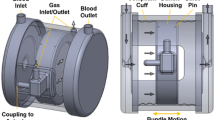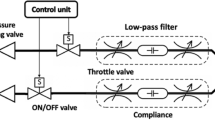Abstract
The purpose of this study was to assess and quantify the beneficial effects of gas exchange according to the various frequencies of the sinusoidal wave that are excited by a PZT actuator, on patients suffering from acute respiratory distress syndrome (ARDS). In this study, an experimental method for the flow hydrodynamics was developed through a bundle of sinusoidally vibrated hollow fibers to observe how well vibrations might enhance the performance of the VIVLAD. We measured the effect of the various excitation frequencies of the PZT actuator on the gas transfer rates and hemolysis from the maximum gas transfer rate. As a result, the maximum oxygen transfer rate was reached at the maximum amplitude and through the transfer of vibrations to the hollow fiber membranes. The device was maximum excited by a frequency band of 7 Hz at various water flow rates, as this frequency was the 2nd mode resonance frequency of the flexible beam. 675 hollow fiber membranes were also bundled, within the blood flow, into the device.
Similar content being viewed by others
References
AAMI Standard: Cardiovascular/Neurology Standards for Blood/Gas Exchanger Devices (Oxygenators); August 14 (1998).
Beek, W. L., Muttzell, K. M. K. and van Heuven, J. W.,Transport Phenomena (2th ed.), John Wiley & Sons (ASIA) PTE LTD, Singapore, 262 (1999).
Bird, R. B., Stewart, W. E. and Lightfoot, E. N.,Transport Phenomena (2th ed.), New York, John Wiley & Sons Inc., 675 (2002).
Campell, T. G., “Changing Criteria for the Artificial Lung: Historic Controls on the Technology of ECMO,”ASAIOJ.,40, 109 (1994).
Conrad, S. A., “Major Findings from the Clinical Trials of the Intravascular Oxygenator,”Artificial Organs,18, 846 (1994).
Fazzalari, F. L., Bartlett, R. H., Bonnel, M. R. and Montoya, J. P., “An trapleural Lung Prosthesis: Rationale, Design and Testing,”Artificial Organs,18, 801 (1994).
Fedespiel, W. J., Hout, M. S., Hewitt, T. J., Lund, L. W., Heinrichm, S. A., Litwak, P., Walters, F. R., Reeder, G.D., Borovetz, H. S. and Hattler, B. G., “Development of a Low Flow Resistance Intravenous Oxygenator,”ASAIOJ.,43, M725 (1997).
Gattinoni, L., Pesenti, A. and Rossi, G. P., “Treatment of Acute Respiratory Failure with Low-frequency Positive-pressure Ventilation and Extracorporeal Removal of CO2,”Lancet,2, 292 (1980).
Hewitt, T. J., Hattler, B. G. and Federspiel, W. J., “A Mathematical Model of Gas Exchange in an Intravenous Membrane Oxygenator,”Ann. Biomed. Eng.,26, 166 (1998).
Ichiba, S. and Bartlett, R. H., “Current Status of Extracorporeal Membrane Oxygenation for Severe Respiratory Failure,”Artificial Organs,20, 120 (1996).
ISO/DIS 7199 International Standard: Cardiovascular Implantants and Artificial Organs-Blood-Gas Exchangers (1996).
Kim, G. B., Kwon, T. K., Jheong, G R. and Lee, S. C., “Gas Transfer and Hemolysis Characteristics of a New Type Intravenous Lung Assist Device,”J. Biom. Eng. Res.,24(2), 121 (2003).
Lee, S. C. and Kim, K. B., “Liquid Flow and Pressure Drop of an Outside Flow Membrane Oxygenator with Hollow Fibers,”J. Biomed. Eng. Res.,23(1), 27 (2002).
Morin, P. J., Gosselin, C., Picard, R., Vincent, M., Giundoin, R. and Nicholl, C. I. H., “Implantable Artifificial Lung,”J. Thorac. Cardivasc.Surg. 74, 130 (1977).
Mortensen, J. D., “Intravascular Oxygenator: A New Alternative Method for Augmenting Blood Gas Transfer in Patient with Acute Respiratory Failure,”Artif. Organs,16, 75 (1992).
Mulder, M.,Basic Principles of Membrane Technology, AA Dordrecht, Kluwer Academic Publishers, Netherlands, 418 (1996).
Naito, K., Mizuguchi, K. and Nosè, Y., “The Need for Standardizing the Index of Hemolysis,”Artificial Organs,18, 7 (1994).
Nguyen, T. T., Zwischenberger, J. B., Tao, W., Traber, D. I., Herndon, D. N., Duncan, C. C., Bush, P. and Bidani, A., “Significant Enhancement of Carbon Dioxide Removal by a New Prototype IVOX,”ASAIO J.,39, M719 (1993).
Nosè, Y.,Recommended Practice for Assessment of Hemolysis in Continous Flow Blood Pump, West Conshohoken, PA: American Society of Testing and Materials, F04:40-41 (1998).
Pesenti, A., Gattinoni, L., Kobolow, T. and Damia, G., “Extracorporeal Circulation in Adult Respiratory Failure,”ASAIO Trans.,34, 43 (1988).
Snider, M. T., Campbell, D. B., Kofke, W. A., High, K. M., Russell, G. B., Keamy, M. F. and Williams, D. R., “Venovenous Perfusion of Adult and Children with Severe Acute Respiratory Distress Syndrome,”ASAIO Trans.,34, 1014 (1988).
Snider, M. T., “Clinical Trails of an Intravenous Oxygenator in Patients with Adult Respiratory Distress Syndrome,”Anesthesiology,77, 855 (1972).
Streeter, V. L., Wylie, E. B. and Bedford, K.,Fluid Mechanics (9th ed.), New York, McGrew-Hill Inc. (1998).
Tanishita, K., Richardson, P. D. and Galletti, P. M., “Tightly Wound Coils of Microporous Tubing: Progress with Secondary Flow Blood Oxygenator Design,”Trans. ASME,21, 216 (1975).
Vaslef, S. N., Mockros, L. F., Anderson, R. W. and Leonard, R. J., “Use of a Mathematical Model to Predict Oxygen Transfer Rates in Hollow Fiber Membrane Oxygenators,”ASAIO J.,40, 990 (1994).
Weinberger, S. E.,Principles of Pulmonary Medicine, Philadelphia: Saunders (1992).
Weissman, H. M. and Mockros, L. F., “Gas Transfer to Blood Flowing in Coiled Circular Tubes,”J. Eng. Mech. Div. ASCM.,94, 857 (1968).
Woodhead, M. A., “Management of Pneumonia,”Respir. Med.,86, 459 (1992).
Author information
Authors and Affiliations
Corresponding author
Rights and permissions
About this article
Cite this article
Kim, GB., Kim, SJ., Hong, CU. et al. Enhancement of oxygen transfer in hollow fiber membrane by the vibration method. Korean J. Chem. Eng. 22, 521–527 (2005). https://doi.org/10.1007/BF02706636
Received:
Accepted:
Issue Date:
DOI: https://doi.org/10.1007/BF02706636




